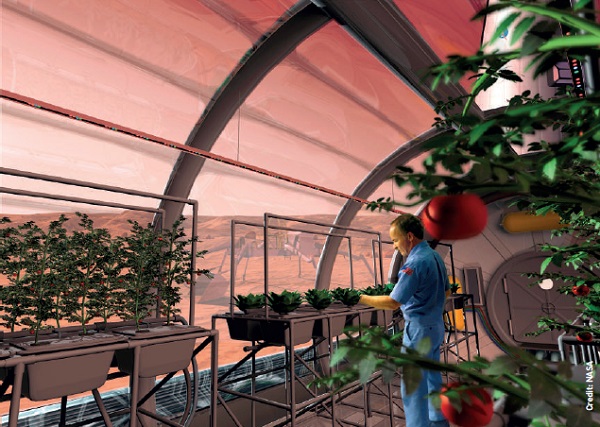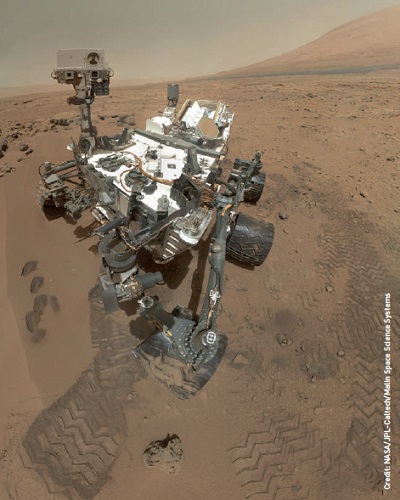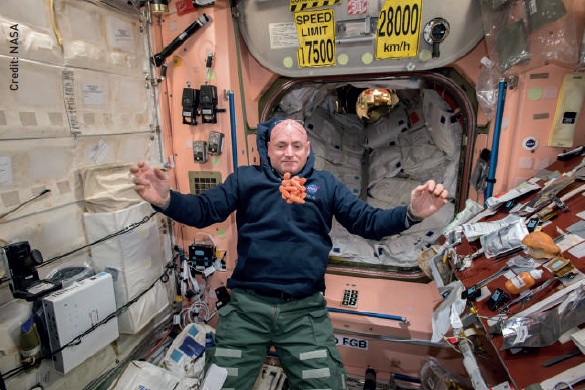To explore deep space, we need to do more than develop new technology. Humans must come to terms with the idea that Earth is no longer their only home. At any given time, there are usually six humans living and working on the International Space Station. The number of off-worlders is only set to increase in the future as we explore more distant worlds. With this distance will come a changing sense of what Earth means to those intrepid human beings who look back at their original home planet.
Donald Pettit is the first astronaut I remember telling me about coming back to Earth with a different sense of home. Don was part of the Expedition 6 crew that was on the International Space Station in 2003 when we lost the Space Shuttle Columbia. He left Earth believing he would return to Florida aboard the shuttle. Instead, he landed in Kazakhstan in a Russian Soyuz vehicle. Don told me that when they opened the hatch and he smelled the grass and dirt, he felt he had come home. After six months in space, home was no longer Florida or Texas, or even the United States. Home was Earth.
As we venture farther from Earth on our journey to Mars, our sense of home will continue to change. The farther we go into space, the bigger – and smaller – home will become. At any given time, there are usually six people living aboard the International Space Station (ISS). Over two hundred miles above the planet’s surface, Earth is a dominant presence, filling the window. Countries are easily recognized; cities can be identified. Astronauts connect with loved ones by sharing their unique view of familiar places like football stadiums, rivers, and mountains and amaze the world by capturing aurora pictures from above. The crews are off the Earth but still connected in strong ways to the planet.
Rather than a globe in the sky, Earth from Mars is merely a bright dot. Home will seem very small indeed.
Farther out, from the Apollo astronauts’ vantage point on the Moon, Earth was seen as a separate world, a bright globe in the dark sky. Although no longer the dominant view in the window, the crews were still connected to Earth as a home through nearly constant and real-time communications with mission control. However, for the human beings standing on the surface of Mars, Earth will look far different. Rather than a globe in the sky, Earth from Mars is merely a bright dot. From a hundred million miles away, home will seem very small indeed.
 The view that future explorers will know as ‘home’ – the Earth-Moon system, as seen in 1990 by the Galileo spacecraft
The view that future explorers will know as ‘home’ – the Earth-Moon system, as seen in 1990 by the Galileo spacecraft
I have a picture of Earth taken in 1990 by the Galileo spacecraft on its way to Jupiter. From a distance of 4 million miles our home appears a planetary system, with Earth and our Moon travelling as a pair. If astronauts coming back from the ISS see the entire Earth instead of individual countries as their home, the first humans returning from Mars will likely find that, after months of travel through the void of space, the vision of a blue planet with a single orbiting moon will create the feeling of home. In order to gain the in-space experience we will need to journey farther out into deep space, we must think about home the same way as those astronauts.

Preparing for Mars
First, we must make our sense of home include our Moon. Technically, we are considering using the Earth’s and Moon’s gravity to slow the returning crewed vehicle from Mars. Crews would rendezvous with their Earth return capsule around the Moon and return to Earth from the Moon’s orbit. If this approach is adopted, the Earth-Moon system will be home to our returning astronauts.
Second, just as astronauts on the Space Station talk about how geopolitical borders and boundaries fade from importance the longer they observe our planet from orbit, we must also recognize that the journey to Mars will be a process of breaking down walls and bringing together the best of what we are capable of as humanity.
Today, many have a tendency to think of space exploration in terms of one thing or another. Humans or robots? National or international? Commercial or government? Earth orbit or deep space? Exploration or pioneering? Actually, the most important word on the journey to Mars will be ‘and’. This endeavour is the most ambitious we have ever undertaken. It will require human and robotic skills, national and international efforts, commercial and government capabilities in Earth orbit and deep space conducting exploration, and pioneering all working together. The word ‘journey’ is also an important one to contemplate. This is not a one-time mission or event. We are placing humanity on a trajectory of interplanetary existence. This thinking shapes the timeframes and systems we build and operate.
In discussions about sending humans to the Red Planet, one often hears the truism “Mars is hard”. This is an understatement. The challenge of Mars is immense. Astronauts travelling from Earth to Mars will likely be in transit for six to eight months. We must provide them with a habitat capable of housing them and their supplies for the long trip, ensuring fresh air and water. We will need to investigate using resources available at Mars, and possibly the Moon, to reduce the amount of supplies that they must carry. On the way, they will be exposed to more radiation than has ever been experienced in human spaceflight. They will need protection from that exposure, and in that respect the timing of the mission will be important. The RAD instrument on the Curiosity rover provided radiation data on its flight to Mars. It is providing daily readings of the radiation environment on Mars. It is interesting to see the radiation levels change as Mars’s atmosphere expands and contracts with the changes from day to night.
Mars landing
Upon reaching Mars, there is the substantial challenge of entry, descent and landing. The gravity and atmosphere are too great for landers like those that took us to the Moon to work, but the atmosphere is also too thin for either the parachutes of Apollo or the wings of the space shuttle. In 2012, the Curiosity rover’s “Seven Minutes of Terror” to the Martian surface, which included a heat shield, parachutes, and skycrane, maxed out our current ability to land something on the surface of Mars – the one metric ton equivalent of a smart car. In order to achieve human landings, that capability must increase at least twenty-fold.
 A surface outpost on Mars, complete with a hydroponic greenhouse to supply food to the colonists
A surface outpost on Mars, complete with a hydroponic greenhouse to supply food to the colonists
Astronauts will need a surface habitat during their stay on Mars, to be a shelter to protect them from harsh conditions. Power must be generated for the mission duration. They will learn to use the resources available on Mars from precursor missions like the Mars 2020 rover, which will carry an experiment to investigate the technology needed to extract oxygen from the carbon dioxide rich atmosphere of Mars. They will need tools to conduct scientific research. And, of course, they’ll need a launch vehicle powerful enough to lift them back into space.
When astronauts launched from Earth on the shuttle, they had the support of a large and capable team at Kennedy Space Center. When astronauts leave planet Mars, they’ll have to do it independently. Finally, after again facing the challenge of months of interplanetary transit, they must survive another entry, descent and landing, bringing them safely back to the surface of Earth.
 The Curiosity rover has an instrument called RAD, which measured radiation all the way to Mars and is still providing daily readings
The Curiosity rover has an instrument called RAD, which measured radiation all the way to Mars and is still providing daily readings
Each challenge requires us to develop systems or capabilities we do not currently have. In order to reach the goal of footsteps on Mars, we will take a three-phase process of developing and testing these capabilities, beginning with the ‘Earth-reliant phase’, then moving into the ‘proving ground’, and finally becoming ‘Earth independent’.
Every day for the past 15 years, humans have been living and working aboard the ISS. Together, spacefaring nations from around the world have established a lasting human presence in space, but that outpost is still extremely dependent on our home planet. Crews rotate and new supplies are launched several times each year. If anything catastrophic were to occur, home is hours away. We have proved that crews can live and work in the harsh environment of low-Earth orbit with regular resupply and contact with Earth. This is a big first step, but not as big as the steps ahead.
In order to go to Mars, we will need to stay in space without crew rotations, without resupply, and without the ability to return to Earth at any time. We begin to develop those capabilities for tomorrow by using the outpost – and relative safety net – that we have today.
ISS dress rehearsals
Aboard the ISS today, astronaut Scott Kelly and cosmonaut Mikhail Kornienko are conducting a ‘Year In Space’ mission, teaching us how the human body reacts during long-term exposure to microgravity, and how we can mitigate the impacts. In addition to biomedical research, they and future crews will continue to learn how to maintain and operate spacecraft for long durations. Without the ability to send replacement parts to a Mars vehicle, we will need to have a deep understanding of what can go wrong on a vehicle, what can be fixed, and what repair equipment is needed. Crews today are experimenting with more autonomous operations for the missions of tomorrow.
To maximize the results from our Earth-reliant phase, NASA is working with commercial partners Boeing and SpaceX to develop a new crew launch capability alongside the commercial cargo capability currently provided by SpaceX and Orbital ATK. These capabilities will provide greater access to the ISS, allowing more astronauts to contribute to our experience and understanding.
NASA’s investments promise to create new opportunities for the development of Earth-orbit. Additional access to the ISS will make possible broader use of the station as an orbital science laboratory, and the space transportation systems our partners are developing will make it possible for others to invest in Earth-orbit capabilities.
As NASA moves from Earth-reliant into the ‘proving ground’, commercial space facilities need to gain a foothold in low-Earth orbit. What we have learned from the ISS are the benefits and necessity for international cooperation. The ISS would not have been possible without international support and the demands of human activity beyond low-Earth orbit will also require international involvement.
When Americans recall the efforts to reach the Moon in the 1960s, two moments in particular stand out – US President John F Kennedy saying, “We choose to go to the Moon…” and Neil Armstrong saying “…one giant leap for mankind.” Decades later it is easy to forget all that happened between those two moments. When Kennedy made his speech, the United States had only a few minutes of spaceflight experience, gained by Alan Shepard atop a repurposed nuclear missile.
 NASA astronaut Scott Kelly eyes a floating bunch of fresh carrots as part of his year-long stay aboard the ISS
NASA astronaut Scott Kelly eyes a floating bunch of fresh carrots as part of his year-long stay aboard the ISS
Going from there to the ability to land two men on the Moon and return them safely home was the result of a great amount of work in developing and proving new capabilities and vehicles – rendezvous and docking, extravehicular capability, weeks-long mission duration, the Apollo capsule, the Saturn rockets, and the lunar lander. Our spaceflight capability today is much greater than it was when Kennedy announced his vision in 1961, but the challenges of reaching Mars are much greater than those of reaching the Moon. Many more new systems and capabilities will be required to carry out the mission. Just as the Gemini missions of the 1960s helped us gain the experience and abilities we needed to go to the Moon, the proving ground of the lunar vicinity is where we will gain the experience and demonstrate the abilities we need to reach Mars.
Developing the hardware
The first systems we will need for the proving ground are already in development. In December 2014, the Orion crew vehicle made its first uncrewed test flight. It reached 15 times greater than the orbit of the ISS before returning to Earth after a successful mission. Today, rapid progress is being made on Space Launch System, a new rocket that will be more powerful than the Saturn V and will provide the heavy lifting for the systems needed for the journey to Mars.
In just a few years, SLS will launch Orion on another uncrewed test flight around the Moon, and then the second launch of SLS will send astronauts farther into space than any human being has ever gone. For this flight, Orion will need a service module. This critical propulsion system for Orion will be built by the European Space Agency. SLS and Orion will then be used to test new systems, including deep-space habitation, in a series of increasingly ambitious proving ground missions.
As we move into the proving ground, we go as an international community with various partners providing critical capabilities. Human spaceflight is dependent on international cooperation.
When talking about human exploration of Mars, it’s important to remember that we’re already there. For 50 years, our robotic ambassadors have studied the Red Planet, giving us increasingly greater understanding of its mysteries. In recent history we were unsure whether there was water on Mars; today, we are studying the planet’s habitability. Robotic orbiters and landers from many nations will continue to prepare the way for the first human visitors while we gain experience in the Earth dependent and proving ground phases.
Once we have accomplished the goals of the proving ground, we will begin moving towards Mars. There may be missions in the vicinity of Mars before the landing. The moons of Mars, for example, offer opportunities to test capabilities and conduct valuable scientific research without requiring complex Mars landing systems. Ultimately, we will complete the next “giant leap” when human beings take their first steps on the surface of another planet.
In NASA, we challenge ourselves to become “Mars Ready”. We know that there are many obstacles and we also know that the international community, working together, can solve them. Each solution will teach us more about ourselves and our planet. The destination of this journey is Mars, but its goal is Earth independence. The crews of these early missions travel as scientists, but also as pioneers. They will teach us more about Mars, but they will also teach us about how to live away from Earth. The first step taken on Mars will make history and it will also be an important step toward making the Solar System our home.














